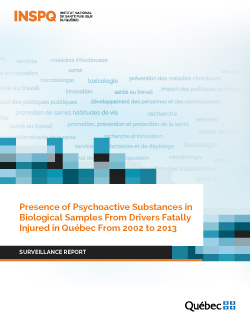Presence of Psychoactive Substances in Biological Samples From Drivers Fatally Injured in Québec From 2002 to 2013
Since 2002, the number of road traffic deaths in Québec has been falling steadily, even though the number of motor vehicles on the road – automobiles, in particular – has increased considerably. Nevertheless, the use of alcohol, drugs and medications is frequently cited as a cause of road traffic accidents by public authorities, since these psychoactive substances have the potential to impair driving.
The aim of this study is to present a profile of the psychoactive substances (i.e. alcohol, drugs and medications) examined and detected among motor vehicle and motorcycle drivers aged 16 years and over who were killed in road traffic accidents in Québec from 2002 to 2013.
The main findings are as follows:
- The presence of psychoactive substances in the drivers of motor vehicles figured among the circumstances of death, but no assessment of a causal link between this presence and road traffic accidents was made.
- The proportion of fatally injured drivers who tested positive for at least one of the psychoactive substances studied increased from 2002 to 2013, although the variation was not significant. That being said, an increase was observed among drivers aged 16 to 34 years and 55 to 64 years. The figures for drivers aged 35 to 54 years remained fairly stable. Finally, the only decrease noted concerns the group of drivers aged 65 years and over.
- Alcohol and drugs were detected among men in the majority of cases, whereas a greater proportion of women than men tested positive for at least one medication. In particular, the combination of alcohol and drugs was encountered more often among drivers aged 34 years and under, in contrast with the combination of alcohol and medications, which was higher among women drivers aged 35 years and over.
- Alcohol, alone or in combination with other substances, was the psychoactive substance most often encountered in positive toxicology tests. All the same, a downward trend was observed in the number of fatally injured drivers who tested positive for high blood alcohol concentrations. However, among fatally injured drivers who tested positive, 80% posted a blood alcohol level over the legal limit set for Québec (80 mg/100 ml of blood, or 0.08%).
- A slight increase was noted in the proportion of fatally injured drivers who tested positive for at least one drug. More than 90% of that number presented positive toxicology results for cannabis, cocaine, or a combination of both drugs. A statistically significant increase was also observed for methamphetamine. Furthermore, a majority of fatally injured drivers who tested positive for methamphetamine or cocaine presented blood concentrations that could have altered their driving performance, based on comparisons with the concentrations reported in the scientific literature.
- The proportion of fatally injured drivers who tested positive for at least one drug was highest among people aged 16 to 24 years (47%). This share then declined with age, in contrast with the proportion of drivers who tested positive for at least one medication, which tended to increase with age.
- A statistically significant increase in the proportion of fatally injured drivers who tested positive for antidepressants was noted. In contrast, the proportion of drivers who tested positive for anti-anxiety medication was seen to decrease. Both classes of drugs were often encountered among fatally injured drivers aged 35 years and over who tested positive for at least one medication. More than a quarter (28%) of fatally injured drivers aged 65 years and over used at least one psychoactive medication.


